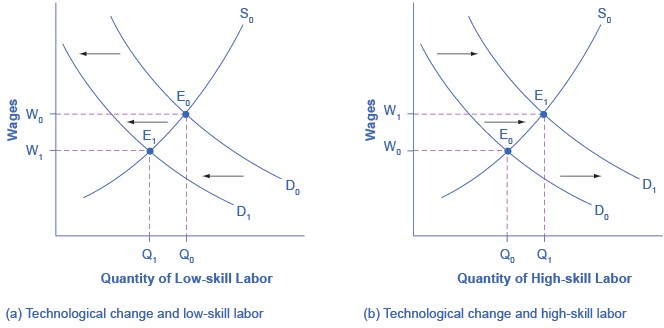How does Technology affects Demand for Labor?
Economic events can change the equilibrium salary (or wage) and quantity of labor. Consider how the wave of new information technologies, like computer and telecommunications networks, has affected low-skill and high-skill workers in the U.S. economy. From the perspective of employers who demand labor, these new technologies are often a substitute for low-skill laborers like file clerks who used to keep file cabinets full of paper records of transactions.
However, the same new technologies are a complement to high-skill workers like managers, who benefit from the technological advances by having the ability to monitor more information, communicate more easily, and juggle a wider array of responsibilities.
Technologies affect the wages of high-skill and low-skill workers
The four-step process of analyzing how shifts in supply or demand affect a market works in this way:
Step 1. What did the markets for low-skill labor and high-skill labor look like before the arrival of the new technologies? S0 is the original supply curve for labor and D0 is the original demand curve for labor in each market. In each graph, the original point of equilibrium, E0, occurs at the price W0 and the quantity Q0.

Step 2. Does the new technology affect the supply of labor from households or the demand for labor from firms? The technology change described here affects demand for labor by firms that hire workers.
Step 3. Will the new technology increase or decrease demand? Based on the description earlier, as the substitute for low-skill labor becomes available, demand for low-skill labor will shift to the left, from D0 to D1. As the technology complement for high-skill labor becomes cheaper, demand for high-skill labor will shift to the right, from D0 to D1.
Step 4. The new equilibrium for low-skill labor, shown as point E1 with price W1 and quantity Q1, has a lower wage and quantity hired than the original equilibrium, E0. The new equilibrium for high-skill labor, shown as point E1 with price W1 and quantity Q1, has a higher wage and quantity hired than the original equilibrium (E0).
Many economists believe that the trend toward greater wage inequality across the U.S. economy is due to improvements in technology.
Related Topics
- Labor Economics
-
Labor Market Equilibrium
- Labor Market
- Labor Market Equilibrium
- Labor Market Efficiency
- Price, Supply, and Demand in the Labor Market
- Equilibrium Wage
- Shifts in the Demand for Labor
- What Causes Shifts in the Supply Labor?
- How Technology affects Demand for Labor?
- Minimum Wage as a Price Floor in the Labor Market
- What is the First Rule of Labor Markets?
- Labor Demand in Perfectly Competitive Markets
- Imperfect Competition in Labor Markets
- Monopsony
- Oligopsony
- Labor Market Power of Employers
- What is the marginal Cost of Labor?
- Labor Market Power of Employees
- What is a Bilateral Monopoly in a Labor Market?
- Wage Elasticity of Labor Supply
- Equilibrium in Supply and Demand in Labor Markets
- Shifts in Supply and Demand in Labor Markets
